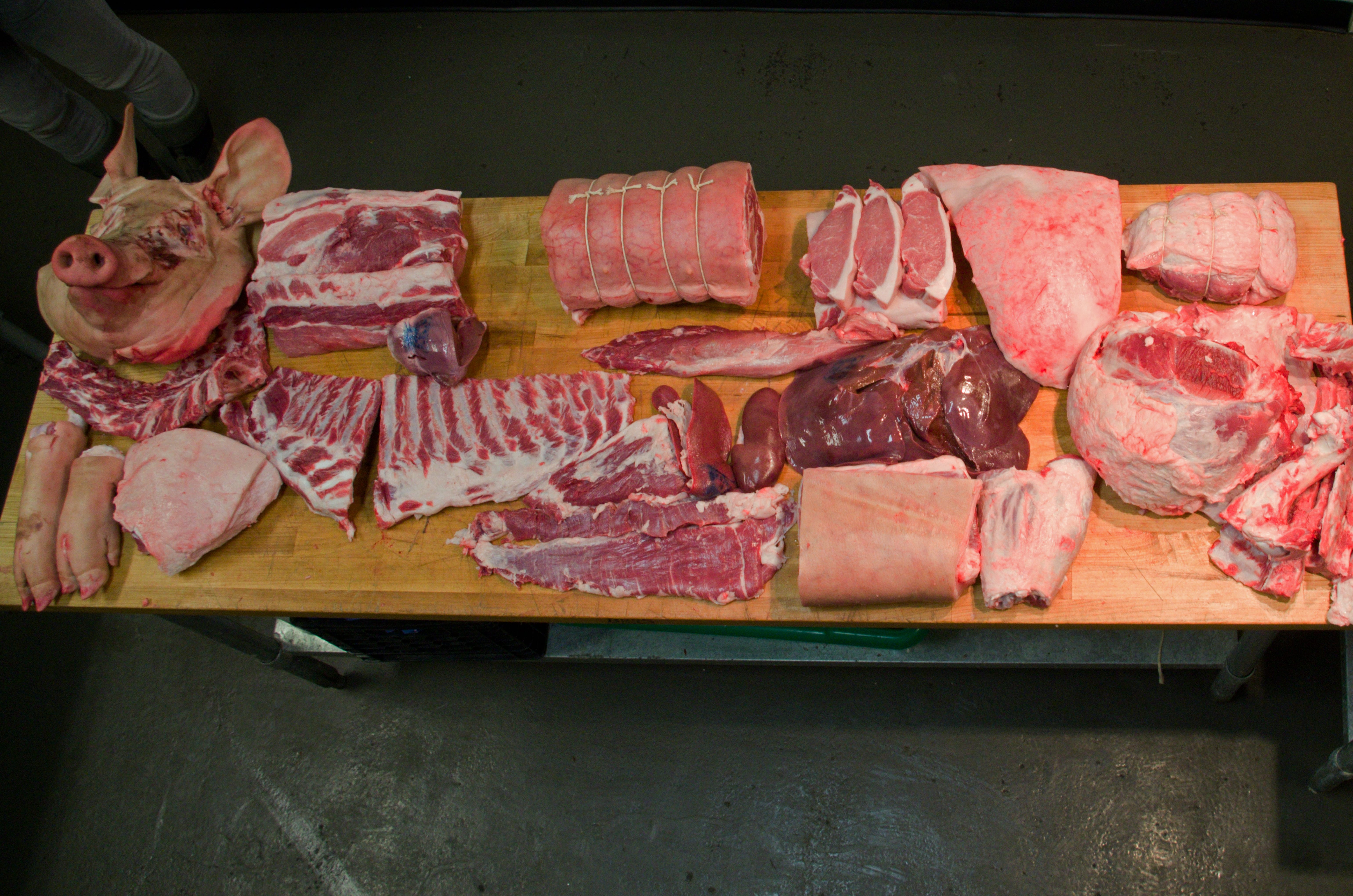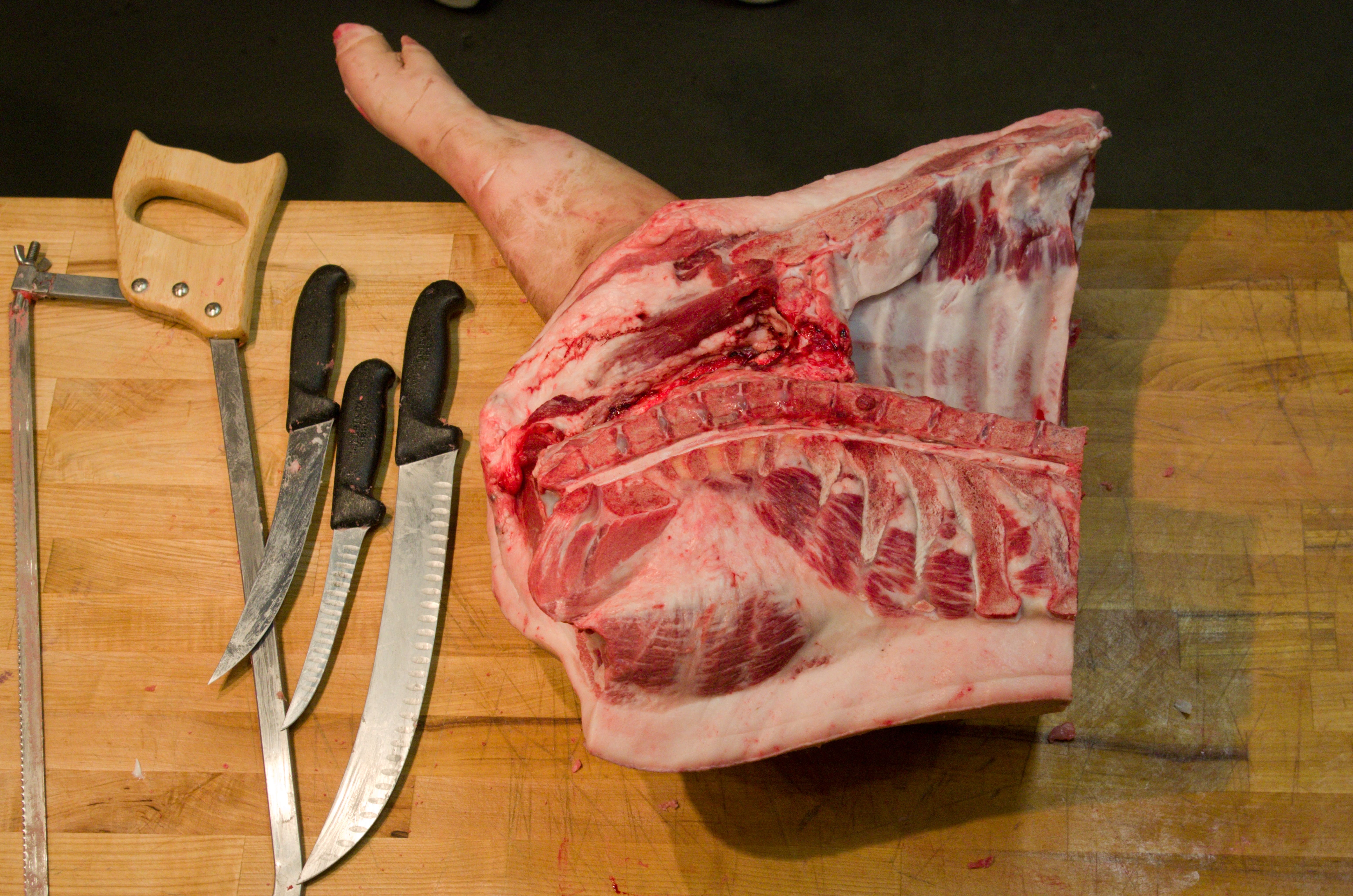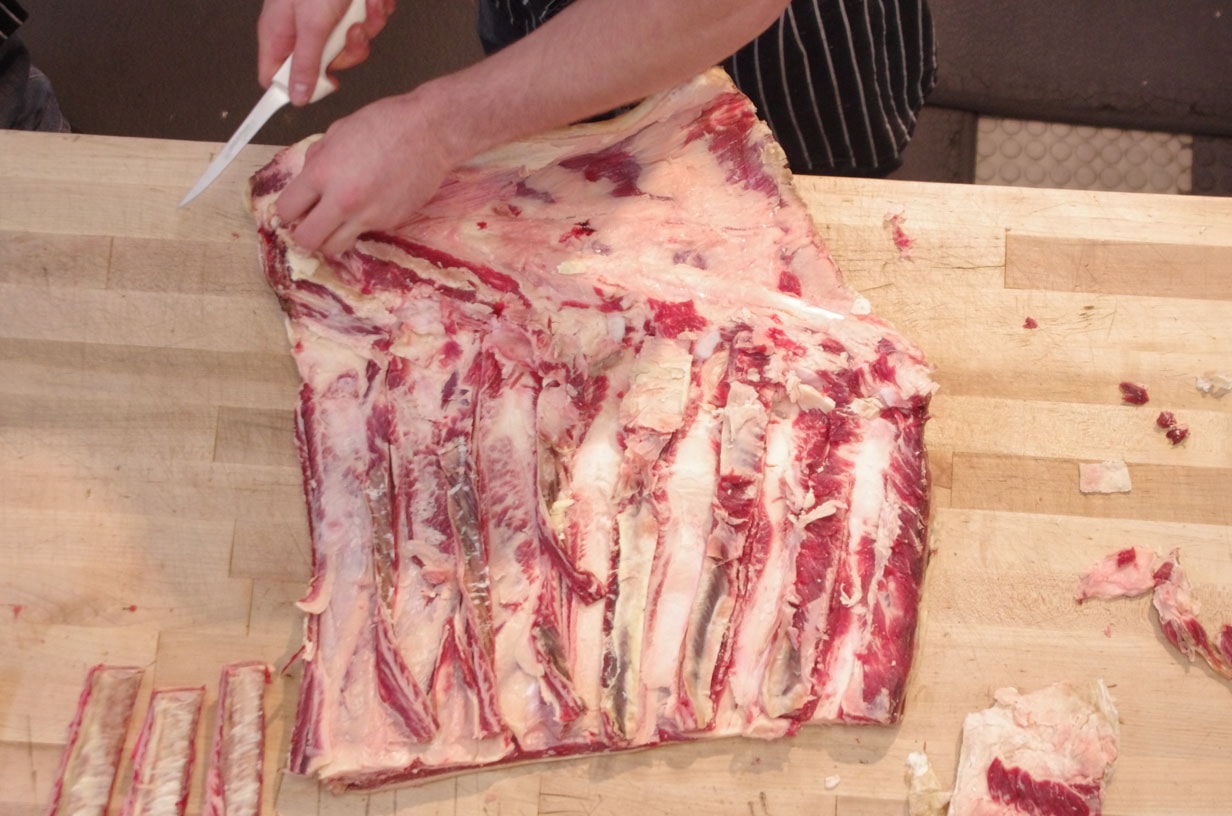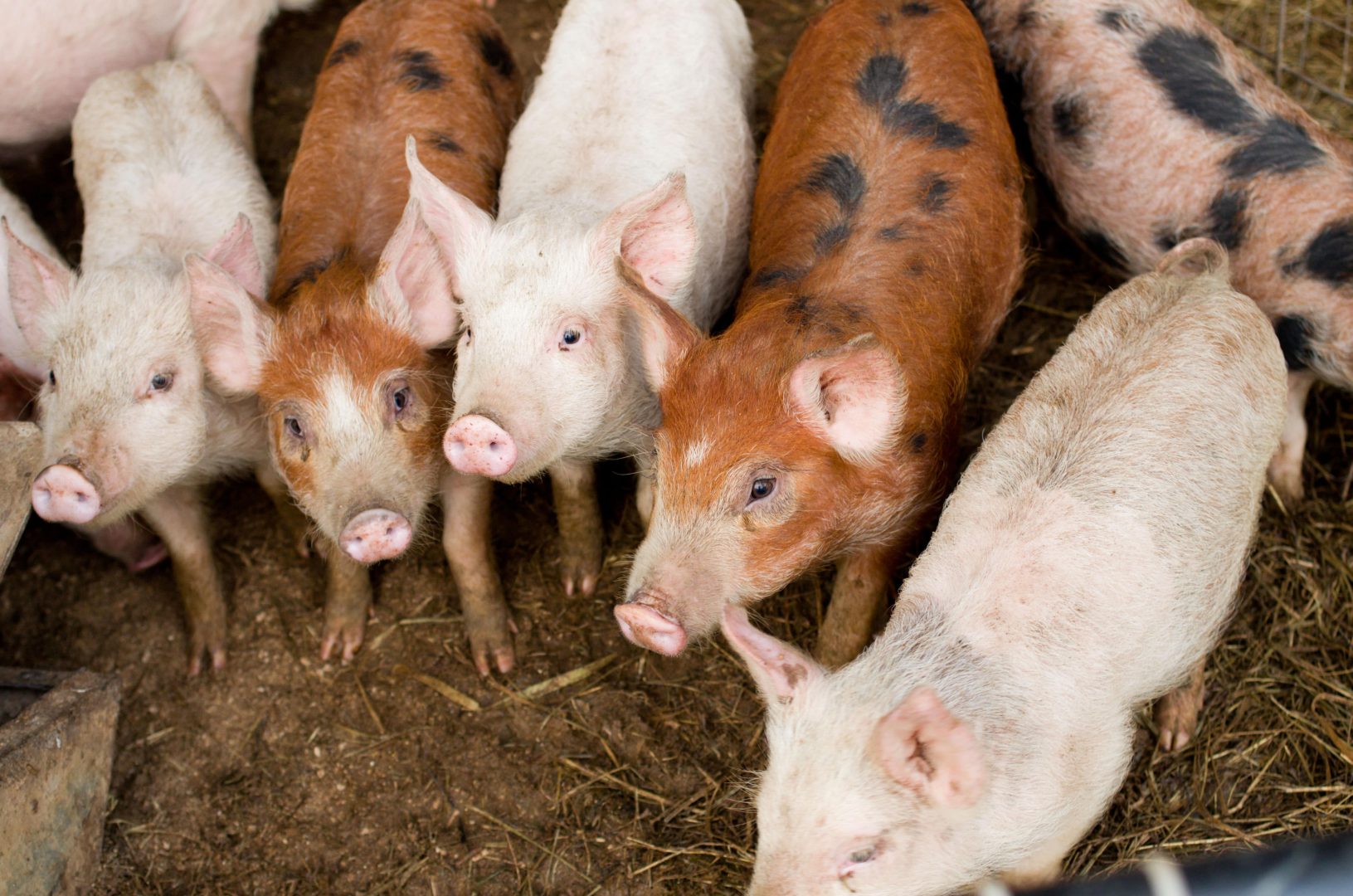
Photo by Cindy Kunst for The Ethical Meat Handbook
By Meredith Leigh, farmer, butcher, and author of The Ethical Meat Handbook, and speaker at the 2016 Sustainable Agriculture Conference, Nov. 4 – 6 in Durham.
Everyone saw that clip on Portlandia about the chicken, right? The comedy sketch poking at modern culture portrayed two awkward diners asking extremely detailed questions about the chicken on the restaurant’s menu, all the way from what it ate, to where it lived, and whether it was able to lovingly put its wing around a chicken “friend.” It’s funny, for sure, and takes the idea of food-aware into the realm of relative absurdity. This does happen, doesn’t it? How funny. How appropriate, and timely this is, encouraging us to laugh at how eccentric it is to care about these things. Or, is it only a little funny (like at the part where the chicken has a name, and papers, etc.), but not truly funny at the root? Is it in fact kind of sad, how caring about the welfare of a bird we decide to eat, and its effects on environment and health is so out of the box as to warrant hyperbolic parody?
It is a little bit of both.
As I reflect on the question of how to make farm-to-table “work,” amidst recent press that attempts to blow the lid off of regionalized local food frauds, and as a huge fan of forward-thinking like Dan Barber’s “The Third Plate,” I think it is useful to look at what we local foodies have done with good intention to um…not really address the problem. To make a name for ourselves as privileged hipsters who don’t have a grasp on the truly accessible hinges of everyday reality. At the same time, I know the political, social, economic, and environmental reasons for our food’s origins being so utterly untouchable by the everyday person. As a result, I also see where foodies have moved the needle in a much-needed way, through actions precisely aligned with those that Portlandia so expertly lampoons.
Here’s the thing, folks: At this moment in time the people with the greatest ability to have a positive impact on animal welfare, soil health, and global warming are the people who eat meat in this country.
If we want that impact to be positive, we need to be the kind of eaters asking about the chicken on the menu.
To understand the priorities in service of clean, safe, and quality food, as well as the living humans, plants, and animals that make it possible, is to see the system as a whole. Farm-to-table implies just this: that integrity and sustainability have been held throughout the food’s journey. In the case of meat, this relates to the animal’s life, death, butchery, and cooking. For all these steps in the meat supply chain to have occurred well is no small feat in regional systems, where farmers, meat processors, butchers, and chefs rely on relationships, a little blind faith, and yes, trends in the market to push a food model that is indeed still largely a misfit, when you look at the way the conventional system works. Without going into a lot of detail about government subsidies and chemical additives, let’s just recognize that if we really want to support positive change, we might want to find it in ourselves to both laugh at Portlandia sketches, without losing the will and the empowerment to ask about the meat on a menu.

Photo by Cindy Kunst for The Ethical Meat Handbook
Below you’ll find my top five recommendations for eaters seeking truly ethical meats on restaurant menus. It is my firm belief that for economic, political, and social reasons, the two groups best poised to inform the greatest amount of change in the meat industry today are the consumer and the much-lauded restaurant chef. Let us not be timid or ignorant in the one place where these two groups come together most meaningfully: the dining room of the farm-to-table restaurant.
CFSA has been bringing the farm to the table for 37 years, and with your help, we can continue to support farmers across the Carolinas as we build a healthy and resilient food system. Join us!
1. Ask how the animal lived AND died.
The precise reason that waiters and chefs are now more educated about the farms and flocks they purchase from is because foodies have done a good job asking about the lives of the animals on the menu. In service of system thinking, we ought to also be wondering whether the animal was afforded a swift and good death. I think you’ll find many waiters still baffled at this question. But if we are seeking for our meat to have quality standards across the supply chain, why should we be taken seriously when we care so deeply about its life, but have zero idea if it met a torturous death? In addition to concerns about welfare and suffering, poor slaughter practice leads to higher waste in processing, and lower meat quality. Add that to your environmental checklist, and your considerations about taste and texture.
2. Look for lesser-used cuts and cooking methods, with the goal of cut not actually mattering.
Eventually. In my book I explain why our demand of “rare-muscle commodity,” i.e ribeyes and filet mignons, has been so instrumental in totally screwing up the way we breed, raise, and eat meat animals. It is an absolute fact that the majority of an animal’s carcass favors slow cooking, and that those steaks we so value and are so accustomed to seeing on restaurant menus are a sign that we are still prioritizing improperly. A perfect example is the recent surge in popularity of the hanger steak. Did you know there is only one hanger steak per beef carcass? Knowing what I know about farm economy and meat processing, it makes the best economic sense for everyone in the meat industry if the end-user buys meat in whole portions. For the restaurant this means whole animals, primals, or subprimals. Guess how many hanger steaks and ribeyes would come out of the kitchen on a weekend in summer, if that were really happening? My dream, eventually, is to be able to read a menu that says something like Beef. Braised with cipollini. Carrot mousse. Fines herbs…and have ZERO idea what muscle I was eating. To trust my local chef enough to know that the cut was whatever the chef needed to use to make best use of the animal’s valuable carcass, and that chef was skilled enough in butchery and cuisine that it would be processed and cooked properly and deliciously. In service of your search for restaurants where chefs are buying whole or favoring lesser used meats, look for organ meats, braised, smoked or otherwise slow-cooked portions, and more unfamiliar restaurant preparations like Denver, ranch, London broil, sirloin, etc.

Photo by Cindy Kunst for The Ethical Meat Handbook
3. Understand that breed obsessions are part of the problem.
How many times have you read “All-Angus Beef Burger” on a menu and thought that you were getting a gold standard? Well, time to turn that marketing effort belly up, exposing it for exactly what it is. There is no universal breed of animal for truly ethical and sustainable meat. What is needed are animals adapted to local and regional environments. Again, in service of sound practice and sustainability across the supply chain, we need to favor animals that produce quality meat and milk while improving the land upon which they live. For farmers, this means deep efforts in developing adapted herds and flocks, which is no small task. Animals that can efficiently feed on grass, without inputs of hormones and antibiotics, and produce top quality meat are not the stud animals raised in the show industry. They are also not the breeds we have been raising for years for the cow-calf market or the auction. They are not the animals raised in a little stall with a constant supply of shade, water, and grain that will then be turned out into pasture and expected to perform. The sooner we get breed obsessions out of our heads and off of our menus, the better chance our farmers have of producing higher quality sustainable meats.

Photo by Cindy Kunst for The Ethical Meat Handbook
4. Expect smaller protein portions, higher prices, and a la carte meat selection.
If things are going well, this is the trend you will start to see in farm-to-table restaurants. No more 8 oz. middle-meat centerpieces (if they happen they will be in limited quantity, on special). No more cheap, huge protein dishes which take advantage of the fact that you’ve paid for the meat before arriving, via your tax dollars to government subsidies, into vertically integrated corporate farms. When we buy meat from local farmers, we must pay the true cost of that product right there at the point of sale. As a result, we will likely begin to eat protein in accordance to what our body actually needs, and meat will be used to flavor and nuance other foods. It’s possible that restaurants will begin building their entrees from pulses, vegetables, grains, and sauces, and you’ll be given the option to add animal protein, at a higher price than you’re accustomed to paying.
5. If you can’t tell, don’t eat it.
To eat meat only once a day, if not less than that, is huge activism. With that in mind, when you find yourself at a restaurant, and you can’t tell what’s going on with the meat on the menu, just stick to non-meat items. This is the greatest individual act an omnivore can take to make a statement about the importance of a good life, a good death, a good butcher, and a good cook.
Buy my book, The Ethical Meat Handbook, for more information on these points, plus recipes and butchery instruction for home cooks.


